Navigation article:
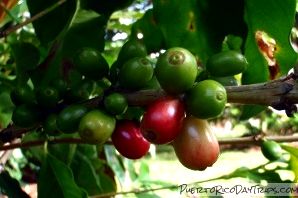
Here’s another bit about us … we don’t drink coffee. But, this doesn’t stop us from growing some coffee shrubbery around the property and being considering coffee production round the island. I have extended been intending to visit a functional coffee plantation (usually referred to as a Hacienda) but kind of felt odd relating to this, because we don’t drink coffee.
As luck might say, my friend and sister-in-law enjoy coffee. And then we needed your entire day in their recent visit and did an trip of Hacienda Pomarrosa. It absolutely was educational and (so they tell me) very tasty!
Really, the most effective Puerto Rican coffee arises from ripe beans grown filled with the awesome, moist mountain areas of the Toro Color color negro mountain range, toward free air travel. There are a number of coffee Haciendas inside the towns of Jayuya, San Sebastian, Ponce, Adjuntas, Las Marias and Lares. It takes over 2 hrs to operate a vehicle to several of these places within the San Juan area, on some twisting, curving roads. So spend time, and anticipate it a complete-trip, and even perhaps anticipate a weekend stay in the area.
Nearly all bigger coffee plantations aren’t open to everyone, however a couple of from the smaller sized sized, niche/gourmet places are open for tours, and purchases. Our tour within the small, flavored coffee plantation Hacienda Pomarrosa ( or Golden Roseapple Farm) was conducted with the owner, Kurt Legner. I’ll spread a couple of from the information we discovered coffee then inform you of our tour.
Good Quality status for Coffee (Around the globe & in Puerto Rico)
Coffee is initially from Ethiopa (Africa). It absolutely was spread from that region with the Moors. Coffee was eventually brought to Puerto Rico in 1736, combined with slave labor required to operate the fields. It had not been the most popular crop, and various hardships (both natural and man-made) made other crops more profitable. As time passes, the grade of coffee increased to get better as well as the world’s taste altered, making coffee an attractive crop.
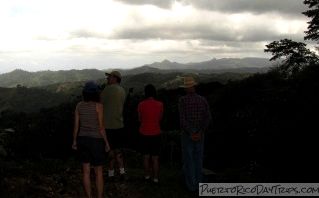
Puerto Rico’s coffee production increased to become significant economic boom for your island. But, mountain existence was hard, picking the coffee is tough work, and jobs were simpler inside the urban centers. In the past, Puerto Rican companies required to follow labor laws and regulations and rules, and growing coffee increased to get less lucrative.
Today, many of the coffee crop goes unpicked because there are inadequate workers ready to be employed in the fields. The island’s curiosity about coffee presently exceeds its production, which necessitates importation of pinto beans (and, enevitably, coffee undesirable unwanted pests). These new undesirable unwanted pests are further reducing producing coffee round the island.
Our Tour at Hacienda Pomarrosa
The tour started getting a pleasant cup of joe along with a couple of homemade blueberry bread inside the outdoors event event gazebo. Essentially we munched round the goodies, Kurt gave us a history of coffee, how he found load it up just like a business, and also the undertake current condition of coffee production in Puerto Rico. As we needed, we headed for the fields (merely a short walk).
Presently, he’s about 3 acres of Arabica coffee plants being created and desires to grow. He shown us fruit round the plants that have been eco-friendly (unripe) and red (ripe). He told us in regards to the coffee borer, an insect that ruins the beans and the way they are trying to keep it in check. He discussed how difficult it’s to hands choose the coffee (it grows on steep muddy hillsides as well as the bags weigh a good deal). In Puerto Rico, the farms are necessary to pay for at least minimum wage (which makes it difficult to get workers, and cuts in to the conclusion).
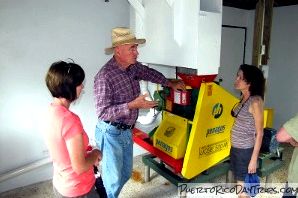
Following a fields, we headed for the production area. The initial stop was the separating area, where they separating the ripe within the unripe fruit, and select any debris. They can sell the unripe and imperfect fruit to a different coffee brands, who allow lots of unripe beans inside their products.
The red (ripe) fruits is going to be sent lower water shoot for the machine that removes the fruit within the bean. Your beans are dried to particular humidity in many machines. Next, they are hulled (detaching the bean in the natural coating).
At the moment on the way, they are referred to as "eco-friendly espresso beansInch, and they might be stored within this condition until they are needed. Whenever a purchase will come in, they roast the beans, then pack them immediately.
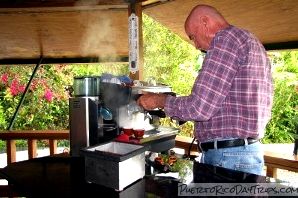
After our tour in the production area, we headed towards the event event gazebo. Kurt made some expresso, therefore we sitting and enjoyed the coffee, company, and awesome weather.
NOTE: Really, a good time to consider an espresso tour is during harvesting/processing time (that’s October to December). For the reason that time, you will see the whole production process from field to roaster. We went in April, and so the shrubbery were just in flower, but Kurt needed us around everywhere, and shown many of us the apparatus as well as the beans they’d in the last stages of production.
Some Good Info On "Puerto Rican" Coffee
For any lengthy time, I have been delivering coffee with a friend in the united states who loves Puerto Rican coffee (cafe). A few years back, the organization she loved disappeared from store shelves and, after trying other brands, she described she didn’t like the taste. I am wondering what went lower.
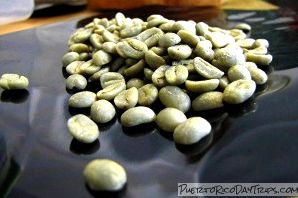
Apparently , CC1 Limited Partnership, parents company of Puerto Rico Coca-Cola Bottlers, purchased about 80% in the island’s coffee market. They produce a lot of the island’s various brands of "Puerto Rican" coffee, beneath the Puerto Rico Coffee Roasters LLC name.
Since Puerto Rico’s coffee demand exceeds local production, a lot of the beans that type in the regular brands of "Puerto Rican" pinto beans are imported off their countries to get coupled with a specific quantity of Puerto Rican beans. Consider the label before buying the conventional grade coffee products— unless of course obviously it states 100% Puerto Rican pinto beans, it most probably isn’t 100% in your town grown coffee.
I remained inside a couple supermarkets studying coffee bags. Many bags say 100% Pure or Hecho en Puerto Rico, but not be fooled. It seems you have to carry out some attempt to seriously Puerto Rican coffee — either go to a niche store or possibly an espresso Hacienda and purchase the gourmet coffees. Or, no less than, really browse the labels inside the supermarket. You can still find a few local growers (some have produced a co-op) that leave regular grade (but nevertheless tasty) 100% Puerto Rican coffee for instance Cafe Cibales and occasional shop Mami. Take into consideration: prices of normal grade coffee are controlled with the government (presently $4.45/lb), so as you spend more, quality (and taste) increases also.
Coffee Tours
In 2008, the Puerto Rico Tourism Company started promoting an espresso Zone, where most of the small gourmet haciendas open their places for the public. This is an effort to market Agrotourism round the island.
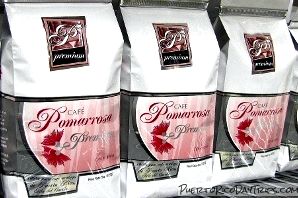
While using the PRTC information, I referred to as all the Haciendas available to get the current (by April 2011) information regarding tours. Most are free, most are low-priced, most offer coffee tastings, as well as them really we imagine you purchase a couple of of the coffee.
You need to call first for reservations also to ensure an British-speaking guide. You’ll be able to drive her, or else you should not brave the roads, there are many tour companies which can make the arrangement and offer transportation.
Hacienda Pomarrosa in Ponce — This really is really the tour that individuals did, therefore we recommend it. Tours are by appointment only. $20/person. Allow 2 hrs for your tour. There is also 2 cottages round the plantation for nightly rentals. Phone: 787-844-3541 or 787-460-8934 or 787-461-8493. Web: the website.
Hacienda Buena Vista in Ponce — This restored mid-1800s coffee plantation is part of the Puerto Rico Conservation Trust. Brought tours are available in Spanish and British. It’s really a museum tour when compared to a "plantation". We visited here in the past, and recommend it. Read our review to learn more and make contact with info.
Hacienda San Pedro in Jayuya — They offer 2 tours (12n & 2pm), on Sunday only. The tour in the facilities is $10/person and takes about 45 mins. Reservations are essential, call Tel. 787-828-2083 Monday to friday from 8:00am to 5:00pm.
Hacienda Tres Picachos in Jayuya — They offer free round the facilities with previous reservations Mondays- Saturdays from 9am-4pm. Call Tel. 787-828-2121. There is also a museum of antiques and artifacts.
Hacienda Tres Angeles in Adjuntas — Coffee Tours on Saturdays 9:00am by appointment only. Tours are a few to 2.5 hrs. From field to cup (which tastings). Tour cost is $15.00 per person, kids around 12 yo $5. Please call to buy (787) 360-0019.
Hacienda Palma Escrita in Las Marias — Open for tours Wednesday to Sunday from 10am to 5pm. $5/person. 45-minute tour with tasting. There is also a gift shop/store plus a cafe (but you will need a reservation for supper). Phone: 787-210-8252
Hacienda Monte Alto in Adjuntas — Supplies a free tour from field to machinery and tastings. Phone: 787-829-5353
The next number of places aren’t round the Puerto Rico Tourism Company "coffee tour" list, though they offer an trip …
Cafe Gran Batey in Utuado — Tour from plant to bag then tasting! Free. Reservations unnecessary, but preferred. Tour lasts roughly 1-1½ hrs. Phone: 787- 636-5442 or 787-608-1246. Web: internet.cafegranbatey.com.
Sandra Farms in Adjuntas — Trip to Origin Coffee Tour – From Planation to Cup, $15 per adult, kids 12 and under free. Reservation needed. Tour lasts roughly 1½ hrs. Phone: 787- 409-8083. There is also a few-master bedroom rental home around the home. Web: internet.SandraFarms.com.
The next couple places supposedly offer tours or educational areas that are around to everyone. Cleaning it once a contacting them while using the information provided through the Puerto Rico Tourism Company, but did not have luck getting solutions via phone/email. Maybe you will have better luck.
Hacienda Lareno in Lares. I hear there is no tour, however, you might take pictures of the farm and buy coffee — 897-3643 or even 787-316-4939
Hacienda Lucero, in Ponce, 787-848-8387.
Hacienda El Jibarito and Hacienda Gripinas are old coffee plantations that are now Paradores, meaning they have been altered into small, fundamental hotels. Are both on “the list” of coffee tours, so you can look at calling. El Jibarito -in San Sebastian, 787-280-4040 and Gripinas, in Juyuya, 787-828-1717.
The next haciendas used to be round the PRTC report on coffee tours and i also couldn’t get in touch with them occasionally, they are not listed, so excellent luck! But you can look at calling to determine if they are still offering anything:
Hacienda Ana Luisa in Las Marias. Not a clue once they offer anything — 787-833-6078. Cafe Dona Ana.
Another recommendations for coffee enthusiasts …
Museo del Cafe in Ciales — Available at 42 Palmer Street, this coffee museum roasts and sells fresh coffee. For me the tour and many types of facts are only in Spanish, however, you are able to call and discover when they have a bi-lingual guide available 787-871-3439. Open Monday to Friday from 8am to 3pm, Saturday/Sunday 8am-5pm. Our summary of the museum.
Coffee Tasting Class at Cuatro Sombras in Old San Juan. Our summary of the course.
Coffee Festival in Maricao — Annual festival, the second weekend in February (but make certain the dates to make certain).
Details For your Hacienda Pomarrosa Tour
The price in the tour is $20/person.
Tours are by appointment only Tuesday-Saturday at 11am. Call, send them an e-mail or use the website to produce a reservation.
Observe that it’s cooler within the hills. It absolutely was 68°F your entire day we when, even though it was 80°F in San Juan. You may want to bring a sweater.
Allow a few hrs for your tour.
You’ll be able to contact them at 787-844-3541, 787-460-8934 or 787-461-8493, to find out more or to produce a reservation.
You can check out the Hacienda Pomarrosa site to find out more to be able to purchase coffee.
Driving directions within the San Juan area: Take Route 52 toward Ponce. Exit onto Route 10 toward Adjuntas. Follow Route 10 to Route 143, where you’ll turn right. Follow Route 143 to Route 511, turn right. Follow Route 511 — Hacienda Pomarrosa will probably be inside your left when you bypass a curve.
Allow no less than 2 hrs for your drive within the San Juan area.
Utilize this map to uncover places stated within the following sentences. You’ll be able to click a placemark to determine the Gps navigation navigation coordinates for the place.
Resourse: http://puertoricodaytrips.com/coffee-tours/
